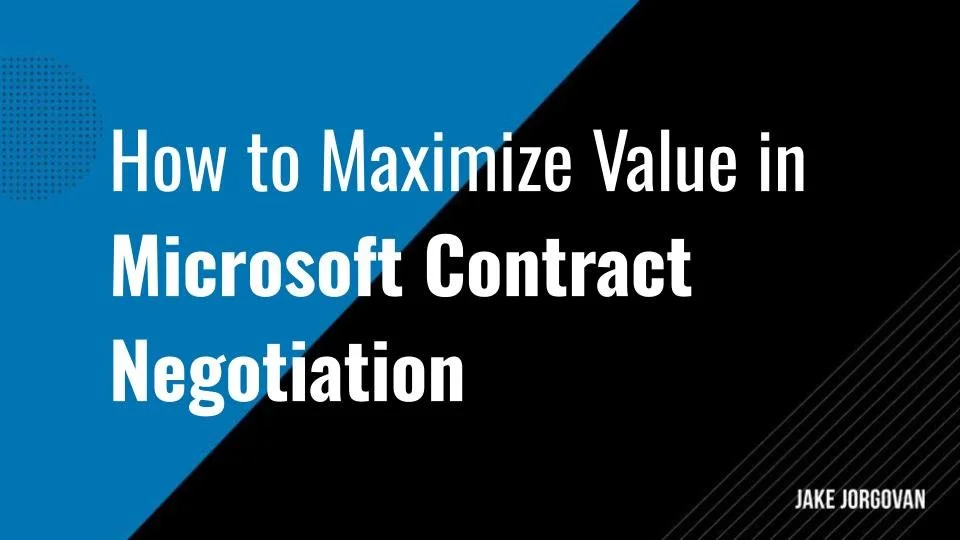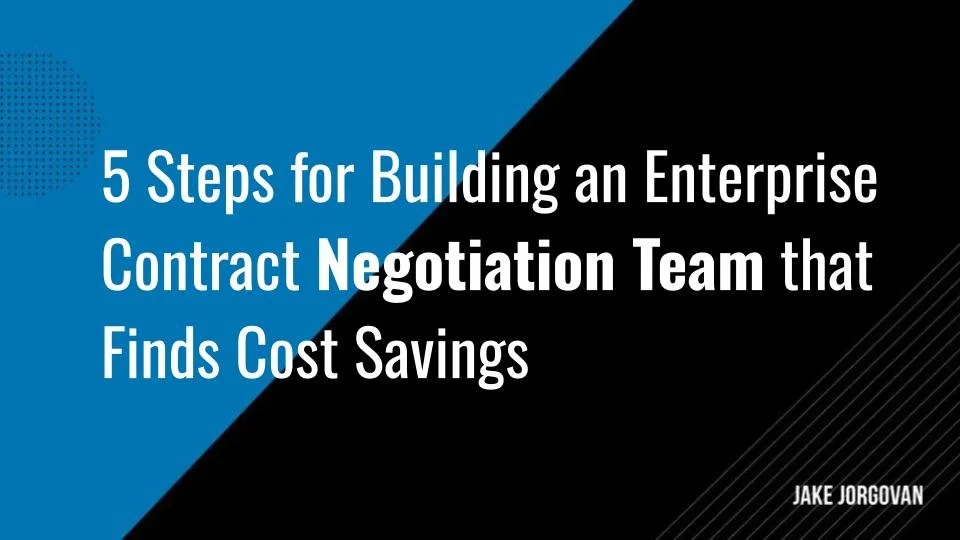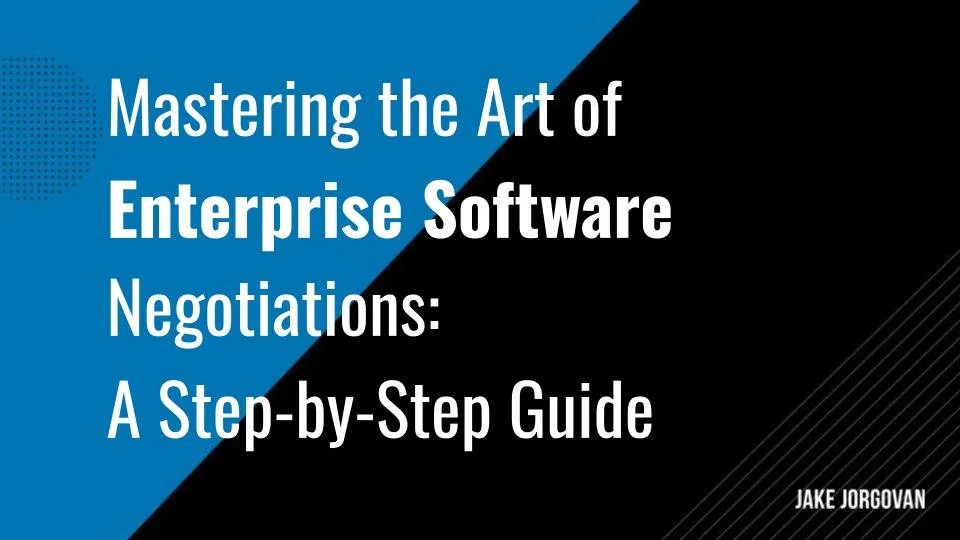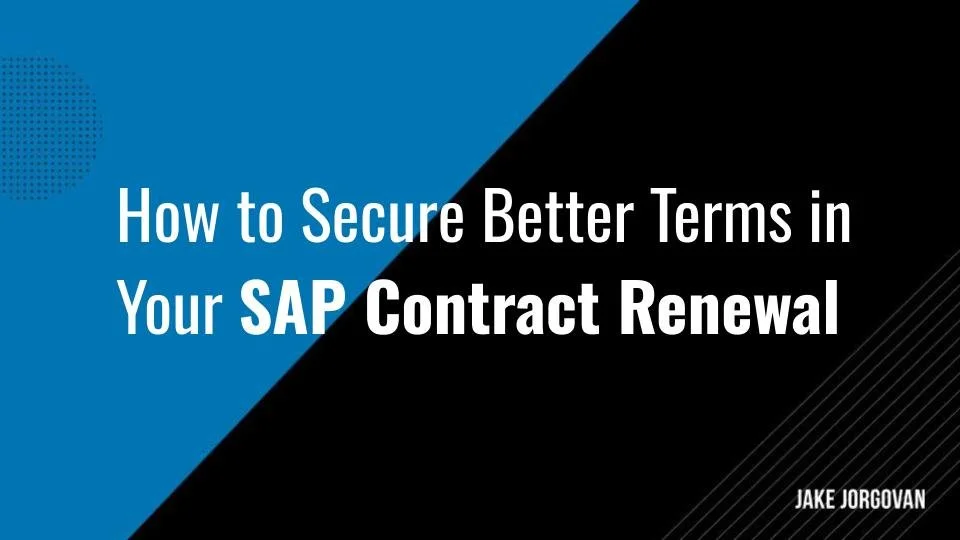How to Maximize Value in Microsoft Contract Negotiation
Different Microsoft licenses offer a ton of powerful and varied benefits. But understanding them can be complex. You need to know what works best for your company so you spend your budget wisely and get access to all the features you need.
Each license type serves a specific purpose. Some offer flexibility, while others focus on security and compliance. The right contract negotiation strategy can save you money and boost efficiency, but you need to approach it right.
This article will guide you through the main types of Microsoft licenses and how to maximize value when agreeing on a new contract.
Some Key Microsoft License Types to Be Aware Of
Microsoft has an excellent suite of products and licenses. Let’s take a quick look at some of the most common and widely-used ones.
Microsoft 365 Business Basic
This license provides essential cloud services like email and online Office apps. It’s ideal for businesses that need cost-effective, entry-level tools for communication and collaboration.
Microsoft 365 Business Standard
This license offers essential productivity tools for small to medium-sized businesses, including the ability to work offline. It’s crucial for companies that need a reliable solution to enhance collaboration.
Office 365 E3
E3 provides advanced security and compliance features. It's important for businesses requiring robust protection and efficient management of their digital environment.
Office 365 E5
E5 includes everything in E3 plus additional analytics and security capabilities. Businesses should care because it offers comprehensive tools for data-driven decision-making and heightened security.
Windows Server Standard
This license is essential for businesses that require a solid foundation for running applications. It's key for companies with moderate virtualization needs.
Windows Server Datacenter
Designed for businesses with high-density virtualization requirements, this license is made for organizations looking to maximize their server resources.
SoME Key Microsoft License Types to Be Aware Of
Microsoft has a ton of excellent products and licenses. Let’s take a quick look at some of the most common and widely-used ones.
Microsoft 365 Business Basic
This license provides essential cloud services like email and online Office apps. It’s ideal for businesses that need cost-effective, entry-level tools for communication and collaboration.
Microsoft 365 Business Standard
This license offers essential productivity tools for small to medium-sized businesses including the ability to work offline. It’s crucial for companies that need a reliable solution to enhance collaboration.
office 365 E3
E3 provides advanced security and compliance features. It's important for businesses requiring robust protection and efficient management of their digital environment.
Office 365 E5
E5 includes everything in E3 plus additional analytics and security capabilities. Businesses should care because it offers comprehensive tools for data-driven decision-making and heightened security.
Windows Server Standard
This license is essential for businesses that require a solid foundation for running applications. It's key for companies with moderate virtualization needs.
Windows Server Datacenter
Designed for businesses with high-density virtualization requirements, this license is made for organizations looking to maximize their server resources.
5 Ways to Maximize Value in Microsoft Contract Negotiation
Let’s explore some of the ways you can get more value when negotiating Microsoft contracts, so you can save money while accessing even more powerful tools and features.
1) Bundle other Microsoft services with licenses for better pricing
It’s often possible to get more value out of your contract negotiation process by bundling other services into your contract alongside the initial license. Here’s how:
Identify services your business already uses, such as Microsoft Azure or Dynamics 365, and assess how they integrate with your current setup. This is the first step to discovering opportunities for consolidation. Tools like Azure Cost Management can help evaluate usage and cost efficiency.
Explore integration opportunities to bring these services together seamlessly. For example, combining Azure with Dynamics 365 may enhance operational efficiency and streamline workflows.
Engage your Microsoft representative and express your interest in bundling these services with your selected licenses. Make your case by emphasizing the long-term commitment and mutual value this arrangement offers to Microsoft.
Request a pricing proposal that reflects a bundled discount. Use your volume and contract duration as leverage to negotiate additional concessions. A tool like Microsoft Volume Licensing Service Center can help estimate potential savings.
Carefully review the pricing proposal to ensure the bundled offer delivers tangible savings compared to purchasing services separately. Conduct a side-by-side comparison of costs before finalizing the deal. Finalize the contract with all negotiated terms documented. Ensure transparency and clarity in terms of usage, costs, and support.
Efficiently implement the bundled services by training your team to maximize their benefits and integrating them with your existing systems. Resources like Microsoft Learn offer free training materials to accelerate adoption.
Pro tip: Microsoft typically offers predefined bundles (e.g., Microsoft 365 Business Premium) that may already include certain combinations of services. It's essential to understand what's included in existing bundles to avoid redundant purchases.
Monitor cost savings and adjust the bundle over time to align with your evolving business needs. Regular evaluations ensure you’re optimizing the value of your bundled agreement.
Many companies consolidate their IT solutions this way. Let’s assume a company is purchasing a Microsoft 365 E5 license — by bundling services like Azure, Dynamics 365, and Power BI with their E5 licenses, businesses can gain significant cost reductions and streamlined management.
2) Leverage your existing relationship with Microsoft for loyalty discounts
If you already have a good customer relationship with Microsoft, you can tap into this goodwill to negotiate a discount based on loyalty. Here’s how to get started:
Start by identifying the key Microsoft account manager you’ve worked with. Ensure they understand your long-term value to Microsoft. Highlight the history of your partnership, and be sure to emphasize your loyalty and consistent use of their products.
Discuss your future plans to continue using Microsoft services. This signals ongoing commitment, which can be leveraged for better contractual terms.
Request a detailed review of your current licenses. Use this to pinpoint where loyalty discounts could apply or where you might benefit from additional services at a reduced cost.
It’s important to negotiate firmly. Use your loyalty and volume of business as leverage to secure discounts or other financial incentives. Document all agreed-upon terms clearly to avoid misunderstandings.
Many companies have successfully used their long-term partnerships to negotiate better pricing on services like Microsoft 365 and Azure. By consistently renewing contracts and showing commitment to using Microsoft's ecosystem, these businesses could secure more favorable terms, such as reduced licensing costs, service-specific discounts, and additional support benefits.
Pro tip: Microsoft has structured programs for discounts based on volume and commitment, such as Enterprise Agreements. The Enterprise Agreement offers built-in savings ranging from 15 percent to 45 percent. You also have the option to spread out your payments by making three annual payments instead of one up-front payment. This helps reduce initial agreement costs and helps you forecast annual software budget requirements up to three years in advance.
The Enterprise Agreement comes with other benefits, too, like those shown here:
3) Negotiate multi-year agreements to lock in favorable rates
If you can commit to a multi-year agreement on your Microsoft contract, this can give you great leverage for negotiations, and it’s often possible to get more favorable rates than shorter contracts. Many companies offer an extra 10–20% discount percentage for multi-year contracts.
Here’s how to do it:
Start by evaluating your current and future needs for Microsoft services. This will help your negotiation team determine the scope of the agreement.
Then, approach your Microsoft account manager. Follow these steps:
Express your interest in a multi-year agreement to stabilize your costs and access annual cost savings.
Request detailed pricing for different contract lengths. Compare the savings for two, three, or five-year agreements.
Highlight your commitment to Microsoft’s ecosystem. Use this as leverage to negotiate better rates and additional perks.
You can then lock in the rates by finalizing a multi-year agreement. Make sure the terms protect you from potential price increases during the contract period.
Of course, you need to review and document all terms carefully. Confirm that the agreement includes flexibility for future scaling or adjustments to your service usage. Take a look at the checklist below for some tips on how to review effectively.
4) Request custom terms that align with your business needs
Generally speaking, a licensing agreement that’s tailored to your specific needs, goals, and circumstances is always better value than a one-size-fits-all solution.
Some organizations have secured double-digit discounts and monetary benefits by negotiating tailored Azure contracts, resulting in over $15 million in cost savings and benefits.
Pro tip: Achieving custom terms often depends on the size and influence of the organization, the overall value of the contract, and Microsoft's willingness to accommodate specific requests. Engage with knowledgeable partners or consultants specializing in Microsoft licensing to navigate complex negotiations effectively.
Here’s how to negotiate custom terms:
Start by identifying your business's specific operational needs.
Find out where standard contract terms may not fully align with your objectives, and look for potential unnecessary costs.
Communicate these needs clearly to your Microsoft representative. Make it clear that flexibility is crucial for your business. Request custom terms. This could include adjusted payment schedules, the ability to scale licenses up or down, or specific support levels tailored to your usage.
Then, negotiate these terms with a focus on how they will benefit both parties. Show how customizations will help optimize your use of Microsoft's services, ensuring a long-term partnership.
Finally, make sure all custom terms are clearly documented in the final contract. This prevents misunderstandings and makes it easier to enforce these terms as needed.
5) Use volume purchasing to gain additional discounts
Volume purchasing is where you negotiate discounts by purchasing multiple licenses or products at once.
In the context of Microsoft licensing, volume discounts can be significant. For example, purchasing through the Enrollment for Core Infrastructure program requires a minimum of 25 licenses and offers a 20% discount on standalone licenses.
Here’s how to do it:
Determine the volume of Microsoft licenses or services you plan to purchase over the next year. Approach your Microsoft account manager with this volume projection. Emphasize that you are considering a bulk purchase.
Request detailed pricing for different volume tiers. Ask for discounts that scale with the volume of licenses you commit to purchasing. Compare the savings between different purchase volumes, and check if the discount justifies the increased expenditure.
Finalize the purchase at the volume that offers the most value. Lock in the discounted rate by securing a long-term agreement that includes price protection.
This approach ensures you maximize cost efficiency by leveraging your purchasing power. It is commonly used in many different industries. For example, volume purchasing is common in technology manufacturing, where businesses will place very large orders together to gain a discount.
Common Mistakes When Negotiating Microsoft Licenses
Here are some of the most common mistakes businesses make when negotiating Microsoft licenses, along with actionable solutions to avoid them:
1. Failing to Understand Licensing Options
Many businesses don’t fully understand the licensing models, such as Microsoft 365 subscriptions, Enterprise Agreements, or the Cloud Solution Provider (CSP) program, which leads to them overpaying for services they don’t need.
Solution: Conduct thorough research or work with a licensing expert to identify the best model for your business needs. Microsoft’s official licensing guides and a review with your account manager can ensure you only pay for what you use.
2. Not Projecting Long-Term Needs
Negotiations typically focus on immediate needs, ignoring future growth or scaling requirements, and this results in frequent renegotiations or costly add-ons later.
Solution: Create a comprehensive forecast of your company’s software and service requirements for at least the next three years. Use this to lock in favorable pricing and flexible terms in your initial agreement.
3. Skipping Volume Discount Opportunities
Businesses sometimes purchase licenses in small quantities instead of bundling them for bulk discounts, losing out on savings.
Solution: Plan and consolidate purchases wherever possible. Microsoft Volume Licensing programs, such as Enterprise Agreements, offer tiered discounts that can significantly lower per-license costs. Always compare quotes for varying purchase volumes before finalizing.
4. Ignoring Compliance Risks
Under-licensing or over-licensing can result in financial penalties or wasted resources. That’s because under-licensing means using more software than is legally covered, while over-licensing is purchasing unused licenses.
Solution: Regularly audit your current usage with tools like Microsoft’s Assessment and Planning Toolkit. Maintain compliance by aligning licenses with active usage and adjusting as needed.
5. Overlooking Negotiation Leverage
Businesses can fail to leverage factors like loyalty, volume purchasing power, or competitive bids to secure better deals.
Solution: Highlight your business’s long-term value to Microsoft, including purchase history, future plans, and competitive offers from alternative providers. Be firm yet collaborative during negotiations to secure perks like price protection or extra support.
Get More Out of Microsoft Contract Negotiation
Maximizing value from your Microsoft products requires a strategic touch. Focus on understanding the specific features of different license types so you can purchase the tools that fit your needs best, and use techniques like bundling and volume purchasing to get better negotiation outcomes.
By taking these steps, you can benefit from all of Microsoft's capabilities while controlling costs.
Stay proactive and adjust as your business evolves so that your investment continues to deliver high returns in both productivity and financial performance.
Frequently Asked Questions
Can you negotiate a Microsoft offer?
Yes, Microsoft offers flexibility for businesses to negotiate terms such as volume discounts, custom payment schedules, and additional support services, especially through programs like Enterprise Agreements (EA).
Is Microsoft changing its service agreement?
Microsoft periodically updates its service agreements to align with evolving compliance requirements, feature updates, and industry standards. Always review the latest terms before renewing or signing a new agreement.
Who can sell Microsoft EA agreements?
Microsoft EA agreements can only be sold by authorized Microsoft licensing partners or resellers who meet specific certification and compliance criteria.
What is EA in Microsoft?
EA, or Enterprise Agreement, is a licensing program designed for organizations with 500 or more devices or users, offering significant discounts, streamlined management, and flexible payment options for large-scale software purchases.
Should I accept the Microsoft license agreement?
Yes, accepting the license agreement is necessary to use Microsoft's products and services legally. However, review the terms carefully to ensure they align with your business needs.






























